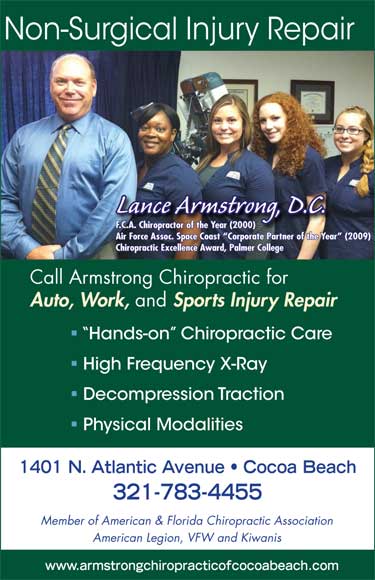Neck, Upper Back Injury Occurs In Rear-End Collisions
By Dr. Lance Armstrong // February 19, 2012
CHIROPRACTIC
One of the most unwanted events we can ever experience is hearing the unexpected sound of skidding tires heading towards our vehicle. Sometimes we have time to look and brace ourselves with the steering wheel, and many report they closed their eyes and smashed the brake pedal with full force of the pelvis and leg, just waiting to feel the impact.
Motor vehicle collisions (MVC) can cause thousands of dollars in vehicle damage from just mild impact speeds as the vehicles are designed to get as much gas mileage as possible.
Safety features like head rests and air bags have reduced MVC fatalities over the past four decades, yet these features can cause unwanted and unintended injury as well. Air bag deployment has incredible force and often can leave burn marks, abrasions found inside the drivers forearms and face.
Neck and upper back sprain and strain injury often occurs in this environment as the classic MVC “whiplash” injury occurs when hit from behind. The creation of high back seats in 1967 helped reduce the travel distance of the skull, and headrests followed soon after in 1969, but must be adjusted to your height to work properly.
I instruct this during the Brevard County Sheriff’s Teen Driving Challenge, and often find it is not done enough when a family shares the vehicle. This MVC related neck sprain can become much worse when a second impact in the front occurs.
Close attention to factors such as impact force vectors are important when evaluating a MVC patient. The arcing backward of the head recoils forward during classic whiplash – add a second impact in the front, as if you were hit from behind into another vehicle while waiting for a red light – and things become more complicated.
From the first impact the head arcs backward, which is called “extension of the neck.” Then, the arc over the neck bones in recoil from the first impact when the second impact (from the front) causes a force vector strait backward.
This can send the skull base into the neck as it arcs forward. Specific damage to many soft tissue neck features like posterior joints and intervertebral disc can result. Neck bones move initially backward, then forward and rotate vertebra out of place.
Chiropractic physicians who focus on injury repair are trained to treat MVC patients regularly, and can also be a common source of referral from medical clinics, as many do not take MVC patients.
Chiropractic physicians who focus on injury repair have radiology, specialty chiropractic tables, decompression traction, physical modalities like muscle stimulation, therapeutic ultrasound – and incorporate massage therapy and rehab procedures to make a very quick response to MVC injury. Referral for further imaging and medication can also occur.
CONSERVATIVE APPROACH
Injuries like ones described here can be ongoing. With first a conservative approach, many patients find their pain reduced quickly, while other MVC patients who had no warning, and/or with high speed injuries, can find ongoing pain from disc herniation and torn ligaments during strain.
Many of these patients will try anything for pain resolution before surgery, yet may need surgery as well.
All professionals in healthcare want you pain free after injury, and for you to stay that way. Unfortunately many injuries like these initiate premature degenerative changes leading to need for x-ray and ongoing further chiropractic and medical care later on in life.
That’s why it’s called permanent injury, and why today you rub your neck after the car wreck occurred years ago.
Dr. Armstrong graduated from the University of Central Florida with a Bachelor of Science degree in Physics. He was a U.S. Air Force Captain, B-52 Flight Instructor, and served during Desert Storm. The 1992 Reduction in Force required a career change, which brought Capt. Armstrong to attend Palmer College of Chiropractic. He graduated as the class recipient of the Chiropractic Excellence Award. In 2000, the Florida Chiropractic Association (FCA) presented him the organization’s Chiropractor of the Year Award, and he was elected president of the FCA in 2005. Dr. Armstrong has attended political events effecting positive change for veterans, active duty military and the public. By making multiple trips to Washington, D.C. and Tallahassee, Florida, he has positively affected patients’ rights both nationally and in Florida. By bringing his two careers together, there are now Chiropractors on 50 military bases. Dr. Armstrong has over 9,000 global patients and treats with hands-on, full spine chiropractic adjustments, physical therapy, physical modalities and rehab.
FOR MORE INFORMATION call 321-783-4455 or log on to Armstrong ChiropracticofCocoa Beach.com












